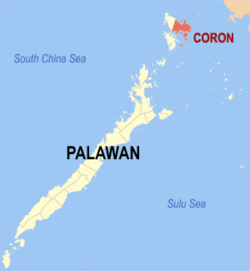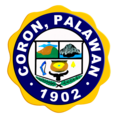Coron, Palawan
Municipality in Palawan, Philippines From Wikipedia, the free encyclopedia
Coron, officially the Municipality of Coron (Tagalog: Bayan ng Coron), is a municipality in the province of Palawan, Philippines. According to the 2020 census, it has a population of 65,855 people.[3]
Coron | |
|---|---|
| Municipality of Coron | |
 Coron skyline | |
 Map of Palawan with Coron highlighted | |
Location within the Philippines | |
| Coordinates: 12°00′N 120°12′E | |
| Country | Philippines |
| Region | Mimaropa |
| Province | Palawan |
| District | 1st district |
| Founded | 1902 |
| Barangays | 23 (see Barangays) |
| Government | |
| • Type | Sangguniang Bayan |
| • Mayor | Mario T. Reyes Jr. |
| • Vice Mayor | Asian Manasseh Lorenzo A. Palanca |
| • Representative | Edgardo L. Salvame |
| • Municipal Council | Members |
| • Electorate | 40,511 voters (2022) |
| Area | |
• Total | 689.10 km2 (266.06 sq mi) |
| Elevation | 8.0 m (26.2 ft) |
| Highest elevation | 957 m (3,140 ft) |
| Lowest elevation | 0 m (0 ft) |
| Population (2020 census)[3] | |
• Total | 65,855 |
| • Density | 96/km2 (250/sq mi) |
| • Households | 16,483 |
| Economy | |
| • Income class | 1st municipal income class |
| • Poverty incidence | 9.84 |
| • Revenue | ₱ 499.2 million (2022) |
| • Assets | ₱ 1,249 million (2022) |
| • Expenditure | ₱ 347.3 million (2022) |
| • Liabilities | ₱ 441.5 million (2022) |
| Service provider | |
| • Electricity | Busuanga Island Electric Cooperative (BISELCO) |
| Time zone | UTC+8 (PST) |
| ZIP code | 5316 |
| PSGC | |
| IDD : area code | +63 (0)48 |
| Native languages | Calamian Tagbanwa Kagayanen Palawano Tagalog |
The main population center of the municipality is composed of Poblacion barangays 1 to 6, where the Municipal Building, the Municipal Legislative Building, and the Judicial Hall of the Municipal Circuit Trial Court are located. Its fiesta is held annually on August 28 in honor of Saint Augustine. It is the commercial capital of the Calamian Islands.
The municipality is home to the Coron Island Natural Biotic Area, which is listed in the natural category of the UNESCO World Heritage Tentative List.[5]
History
Summarize
Perspective
The Calamian Islands were originally inhabited by the Tagbanuas, Calmiananen, and Cuyonon tribes.
Oral history tells that the Datu Macanas ruled the entire Busuanga Island where present-day Coron town lies. Early on Spanish exploration of the islands, Fray de la Concepcion took note of the friendliness of the people of Busuanga Island and the ferocity of the Tagbanua tribe living in Coron Island.
Early on the history of the Calamianes, Coron was directly ruled by the Spanish in Mindoro while the island of Cuyo by the Spanish authorities in Panay. In this area of the Calamianes, the first permanent Spanish settlement was Culion. Coron was a mere visita of Culion at that time. A fort and church were built in Libis, Culion around 1670 by the Spaniards as part of the defenses (along with Cuyo, Taytay, and Linapacan) against the Muslim raids. This became a settlement for migrants to the Calamianes. Don Nicolas Manlavi a Cuyonon served several years in Spanish Galleons, and an Ilonggo from Jaro, Ilo-ilo named Claudio Sandoval later wed Nicolas' only daughter Evarista. The Sandoval clan of the Calamianes came from this union. It was Don Nicolas Manlavi who established the first settlement in Coron which was initially at Banuang Lague (old town) in present-day Banuang Daan in Coron Island. The town center was then again moved to present-day Maquinit and later on, it was finally established in present-day Bancuang in Barangay 5 where a good water source was found. [citation needed]
Late in the 1890s, an American naturalist, Dean Worcester, journeyed through the Calamianes collecting specimens and stayed briefly in Culion. At the turn of the century, he was appointed part of the First Philippine Commission, becoming the Secretary of the Interior. He recommended Culion as the Philippine Leper Colony. This act forced the transfer of the Sandoval clan in 1900 to the various barrios of what is now Coron and Busuanga. The Coron town was settled by the family of Claudio Sandoval, and the other Sandovals settled in what is now Bintuan, Salvacion, Concepcion, and Old Busuanga.
In 1950, the town of Busuanga was created from the barrios of Concepcion, Salvacion, Busuanga, New Busuanga, Buluang, Quezon, Calawit, and Cheey which used to belong to Coron.[6] In 1954, the islands of Linapacan, Cabunlaoan, Niangalao, Decabayotot, Calibanbangan, Pical, and Barangonan were separated from Coron to form the town of Linapacan.[7]
Geography
Summarize
Perspective
The municipality of Busuanga comprises the western part of Busuanga Island, while Coron comprises the eastern part of Busuanga Island, all of Coron Island and about 50 other minor islets stretching as far as Tara Island in the north-east and Canipo Island in the south.[8] All these islands are part of the Calamian Archipelago in northern Palawan that separates the South China Sea from the Sulu Sea.
Barangays
Coron is politically subdivided into 23 barangays. Each barangay consists of puroks and some have sitios.
- Banuang Daan
- Bintuan
- Borac
- Buenavista
- Bulalacao
- Cabugao
- Decabobo
- Decalachao
- Guadalupe (also called Binalabag)
- Lajala
- Malawig
- Marcilla
- Barangay I (Poblacion)
- Barangay II (Poblacion)
- Barangay III (Poblacion)
- Barangay IV (Poblacion)
- Barangay V (Poblacion)
- Barangay VI (Poblacion)
- San Jose
- San Nicolas
- Tagumpay
- Tara
- Turda
Climate
| Climate data for Coron, Palawan (1991–2020, extremes 1950–2023) | |||||||||||||
|---|---|---|---|---|---|---|---|---|---|---|---|---|---|
| Month | Jan | Feb | Mar | Apr | May | Jun | Jul | Aug | Sep | Oct | Nov | Dec | Year |
| Record high °C (°F) | 36.4 (97.5) |
36.1 (97.0) |
37.4 (99.3) |
37.6 (99.7) |
37.6 (99.7) |
36.5 (97.7) |
35.7 (96.3) |
34.7 (94.5) |
34.6 (94.3) |
36.6 (97.9) |
37.0 (98.6) |
36.0 (96.8) |
37.6 (99.7) |
| Mean daily maximum °C (°F) | 32.5 (90.5) |
32.7 (90.9) |
33.1 (91.6) |
34.1 (93.4) |
33.5 (92.3) |
32.1 (89.8) |
30.9 (87.6) |
31.1 (88.0) |
31.2 (88.2) |
32.1 (89.8) |
32.8 (91.0) |
32.3 (90.1) |
32.4 (90.3) |
| Daily mean °C (°F) | 28.0 (82.4) |
28.1 (82.6) |
28.7 (83.7) |
29.5 (85.1) |
29.3 (84.7) |
28.3 (82.9) |
27.5 (81.5) |
27.7 (81.9) |
27.6 (81.7) |
28.2 (82.8) |
28.6 (83.5) |
28.2 (82.8) |
28.3 (82.9) |
| Mean daily minimum °C (°F) | 23.5 (74.3) |
23.6 (74.5) |
24.3 (75.7) |
24.9 (76.8) |
25.0 (77.0) |
24.6 (76.3) |
24.1 (75.4) |
24.3 (75.7) |
24.1 (75.4) |
24.2 (75.6) |
24.4 (75.9) |
24.1 (75.4) |
24.3 (75.7) |
| Record low °C (°F) | 12.2 (54.0) |
13.3 (55.9) |
13.4 (56.1) |
14.0 (57.2) |
18.1 (64.6) |
17.6 (63.7) |
17.1 (62.8) |
17.0 (62.6) |
17.4 (63.3) |
17.2 (63.0) |
16.1 (61.0) |
14.7 (58.5) |
12.2 (54.0) |
| Average rainfall mm (inches) | 19.2 (0.76) |
22.9 (0.90) |
15.4 (0.61) |
37.0 (1.46) |
186.9 (7.36) |
318.7 (12.55) |
521.5 (20.53) |
471.7 (18.57) |
470.4 (18.52) |
241.2 (9.50) |
107.1 (4.22) |
90.3 (3.56) |
2,502.3 (98.52) |
| Average rainy days (≥ 1.0 mm) | 3 | 2 | 3 | 4 | 11 | 17 | 21 | 19 | 20 | 14 | 7 | 6 | 127 |
| Average relative humidity (%) | 78 | 76 | 75 | 76 | 81 | 86 | 88 | 88 | 89 | 86 | 82 | 80 | 82 |
| Source: PAGASA[9][10] | |||||||||||||
Demographics
|
| |||||||||||||||||||||||||||||||||||||||||||||||||||
| Source: Philippine Statistics Authority[11][12][13][14] | ||||||||||||||||||||||||||||||||||||||||||||||||||||
In the 2020 census, the population of Coron, Palawan, was 65,855 people,[3] with a density of 96 inhabitants per square kilometre or 250 inhabitants per square mile.
Economy
Summarize
Perspective
Poverty incidence of Coron
10
20
30
40
50
60
70
2000
64.36 2003
60.08 2006
33.20 2009
28.43 2012
23.45 2015
19.67 2018
17.06 2021
9.84 Source: Philippine Statistics Authority[15][16][17][18][19][20][21][22] |

The main industries of Coron are fishing and tourism.[citation needed] Former industries include manganese mining at Singay Mines in Barangay San Nicolas during the Japanese Occupation period. This was followed by the fishing industry boom during the 1970s up to the 1990s which gradually dwindled due to illegal blast and sodium cyanide fishing. The rattan and basket-weaving industry which also gradually declined during the same period due to the ensuing depletion of raw materials.
Currently tourism is the top industry in Coron due to local beaches, dive sites, Lagoons and other natural tourist spots.[23] A dozen sunken Japanese warships at depths between 10 and 40 meters (33 and 131 ft) off Coron Island is a diving destination,[8] listed in Forbes Traveler Magazine’s top 10 best scuba diving sites in the world.[citation needed] A description of the diving highlights in 2021 is provided by Dive the World.[24]
Siete Pecados Marine Park
On April 17, 2024, the Siete Pecados Marine Park, under Jose Mazo, manager, in Coron, as one of 3 marine protected areas, won the Blue Park Award by Marine Conservation Institute at the 9th Our Ocean Conference in Athens for its role in conservation of marine biodiversity. It is part of the Calamian Islands Network in the Philippines, within a short distance from the coast of Coron. Founded in 2005 by the United States Agency for International Development, it is currently an ecotourism landmark.[25][26]
Transportation
The Francisco B. Reyes Airport serves the town. The airport has direct flights such as Manila, Cebu and Angeles
Gallery
- Church in Coron
- The lagoon going to Kayangan Lake
- Waling Waling Island, Coron, Palawan
- Pitcher plant along the slopes of Mt. Tapyas
References
External links
Wikiwand - on
Seamless Wikipedia browsing. On steroids.









